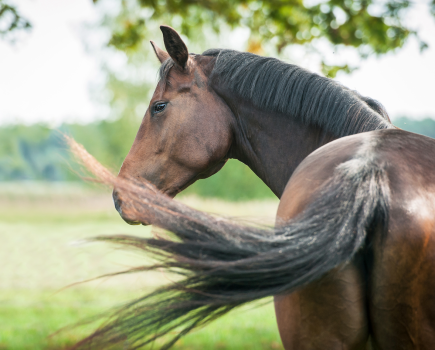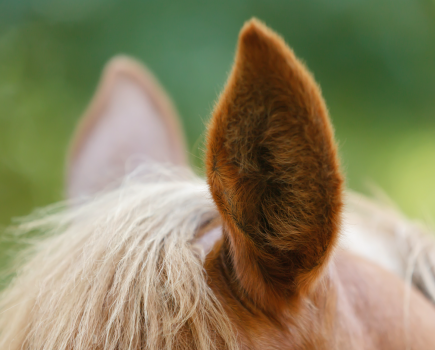Alarming, stressful, costly and hugely disruptive, you really don’t want strangles to hit your yard — and if it does, you’ll be thankful for your horse health insurance policy. “Have you heard the news? It’s strangles.” So began a friend’s text, which sparked three months of disinfectant-drenched upheaval. Because nothing, and I mean nothing, ups the sales of Virkon quite like an outbreak of strangles in horses on a yard. And nothing makes you feel more like a modern day leper than being told that your stables are affected.
I know, because a few years ago my friends and I were in the midst of a breakout. An unsuspecting owner had brought a horse on to the yard who, it turned out, was a carrier. It wasn’t her fault, or the poor horse’s fault (who later made a full recovery, I’m relieved to say). But what it did do was prove how at risk we all are. No one is above this clever little bacterial infection, which has mastered the art of hiding in small pockets in the upper respiratory tract of ‘carrier’ horses, sometimes for years. It can also survive in water troughs and on surfaces, such as wooden fences.
While strangles can be deadly in around 1% of cases, the vast majority of horses go on to fully recover. So, in the western world with its ample antibiotics, strangles is not the killer we might imagine, despite it being hugely contagious. However, as anyone who has ever been on an affected yard will tell you, the emotional scars run as deep as any abscess — and the reaction of neighbouring horse owners to an outbreak can border on the extreme.
I’ve learned that strangles hits hard on multiple levels: it makes your horse feel ill, it costs you a fortune in vet’s bills, it’s hugely upsetting for everyone involved, and it’s a major pain following all the (common sense and very necessary) biosecurity rules. Yes, you will get through it, but prevention is very, very much better than cure. So here’s what we’ve all learned from our outbreak. I hope it helps you to avoid strangles — and helps you cope if it ever does strike.
You’ll need to play nurse
Strangles affects every horse differently, but the ones at our yard looked depressed, snotty and were off their feed. Some, like Mac, in his mid-20s, really took it hard.
“Mac was very down, had no appetite and was missing his field companions as he was confined,” says his owner, Bridget O’Hara.
Others, like my horse Callie, were infected with the disease but showed no symptoms at all. (She had to stay in isolation for five weeks, but was proven clear with a scope.)
You’ll have to be vigilant
Three different zones were put in place at our yard: red, amber and green. Red zones were the areas where we knew infected horses had been; amber the areas where they might have been; green the areas where the healthy horses were. Woe betide anyone who crossed from a red or amber zone to green without dousing their feet in a tray of disinfectant.
To remind us, physical barriers (lines of electric tape) were set up, with trays of Virkon at the entrance and exit. Owners of an affected horse had to deal with their animal, step through the disinfectant, then leave without touching anything, especially another horse.
We all had sets of overalls at the yard to change into and, as horses were tested and proven clear, they moved into the green group. No one came or went unless they absolutely had to be there. No farriers, no equine dentists — and vets only at the end of the day when they had no more yard visits.
I remember the vet coming to give us all a talk on what we should do. Seeing him standing on the ‘safe’ side of the yard gate, us on the other, gave an inkling as to what it must have felt like to have been part of a plague-hit village…
“Strictly no dogs were allowed on the yard, farriers stayed away and no one from other yards came anywhere near,” adds Sara Thompson, who had two older horses at the yard at the time, Millie and Hattie. “Our yard was a no-go area for three months. I work with the local Riding for the Disabled group, but I had to keep away from that yard in case my clothes were contaminated.”
You’ll be glad you’re insured
I have to say a big thank you to my vets, Fellowes Farm Equine Clinic in Huntingdon, as they were incredibly supportive, calm and knowledgeable, making sure we had all the correct regimes in place throughout. “The temperatures of all the healthy horses had to be taken daily, with blood tests conducted regularly so we could be on guard for new symptoms emerging,” says Sara.
But boy was it expensive — for both the owners of the sick horses and the ones who weren’t. Blood tests alone cost each owner of the ‘green’ bunch around £80 a time, while affected horses needed antibiotics, painkillers and a scope to check that they were clear of the disease (at £450 a pop). Most were insured, some not…
You’ll need to stay strong
“During the strangles epidemic life was difficult,” says Sara. “Even though my horses were lucky enough to avoid it, to say it was an emotional roller coaster is putting it lightly. Keeping them healthy didn’t just mean me being vigilant; our whole yard had to be on guard and watchful for any contamination.”
“Be warned: if your yard ever gets it, you will feel extremely isolated,” adds Bridget. “We are a small yard and all tried to support and help one another, but at times it was stressful and extremely emotional.”
Of course, we’ve all lived through Covid-19 and multiple lockdowns plus social separation. That gives you an idea of what it’s like. The main difference being that while the yard was a haven for most of us during the coronavirus pandemic, the place you love most in the world suddenly becomes very stressful.









